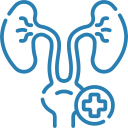While bleeding is common in the days following childbirth, it’s important for new mothers to be aware of the symptoms that indicate something is abnormal and requires medical care.
While the period following childbirth can be joyous, it is also a time of adjustment and recovery for mothers. Immediately after giving birth, a woman’s body undergoes the natural process of shedding the placenta — the organ that nourishes the uterus during pregnancy. There will be bleeding during this postpartum period, but the key is to know how much bleeding is normal, how long it lasts, and how to manage it.
Below, this OB/GYN in East Chicago, Indiana is going to review some facts that will help you differentiate normal lochia (postpartum bleeding) from abnormal lochia. This information can help you avoid undue stress and anxiety — or, in more severe cases, let you know if you need to seek medical attention.
Is your lochia normal?
Lochia is the vaginal discharge that women experience after childbirth. It contains endometrium (the mucous membrane that lines the uterus), blood cells, and uterine tissue. Women will experience bleeding both after vaginal delivery and cesarean section.
- Duration: Normal bleeding continues for about six weeks postnatally. The uterus will undergo changes during this period that will restore it to its natural state. Most OB/GYNs in East Chicago, Illinois will advise women to use menstrual pads instead of menstrual cups or tampons during this period since they could potentially bring bacteria into the still-recovering genital tract and uterus.
- Color: In the first few days following delivery, women may have a reddish-brown discharge. The next stage of lochia is when this discharge becomes brown or pink — this stage often lasts two to three weeks. Next, the color will turn white. This is because most red blood cells have been passed through the bleeding by the end of the third week. This discharge may last up to six weeks postnatally or eight weeks in some cases.
- Amount: The first two weeks after giving birth are marked by heavy vaginal bleeding as the placenta is shed. The bleeding subsides gradually, although it might last up to six weeks. Some new mothers also notice increased bleeding while physically active or breastfeeding.
When should you see an OB/GYN?
New mothers who experience the following symptoms should make an appointment with a licensed obstetrician/gynecologist in East Chicago, Indiana:
- Heavy bleeding
- Having blood clots that are abnormally large (think: golf ball-sized)
- Severe postpartum cramps
- Feeling dizzy or lightheaded
- Blurry vision
- Chills with fever
- Fast heart rate
Childbirth changes everything. For the first few weeks after childbirth, it’s important to remember to celebrate these milestones and be aware of how your body and baby respond. While it is important to focus your care and attention on your newborn child, it is just as important to look after your own health. If you notice any of the signs and symptoms mentioned above, it’s strongly recommended that you visit your East Chicago, Indiana OB/GYN as soon as possible.
Looking for Affordable OB/GYN Care in East Chicago, Indiana? Contact 219 Health Network.
Do you have any additional questions about self-care during the postpartum period, or about adjusting to the new changes? If so, 219 Health Network is here to help. As the premier provider of affordable OB/GYN care in East Chicago, Indiana, we have licensed health professionals on staff who can provide you with all the information and/or medical attention you need. Our network of obstetrics and gynecology specialists includes Jun Kim (MD) and Michele Beigle (CNM). Contact us today at (219) 398-9265 to get in touch with our specialists.


